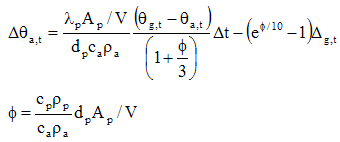Steel Temperature
See Ref.[1], Annexe C.
The increase of temperature Δθa,t in an unprotected steel member during a time interval Δt

With:
|
Am |
the exposed surface area per unit length [m²/m] |
|
V |
the volume of the member per unit length [m³/m] The factor Am/V should not be taken as less than 10m-1 |
|
ca |
the specific heat of steel [J/kgK] |
|
hnet,d |
the net heat flux per unit area [W/m²] |
|
Δt |
the time interval [seconds] The value should not be taken as more than 5 seconds |
|
ρa |
The increase of temperature Δθa,t in an insulated steel member during a time interval Δt

With:
|
Ap |
|
|
V |
the volume of the member per unit length [m³/m] |
|
ca |
the specific heat of steel [J/kgK] |
|
cp |
the specific heat of fire protection material [J/kgK] |
|
dp |
the thickness of the fire protection material [m] |
|
Δt |
the time interval [seconds] The value should not be taken as more than 30 seconds |
|
ρa |
the unit mass of steel [kg/m³] |
|
ρp |
the unit mass of fire protection [kg/m³] |
|
θa,t |
the steel temperature at time t |
|
θg,t |
the ambient gas temperature at time t |
|
Δθg,t |
the increase of the ambient gas temperature during the time interval |
|
λp |
the thermal conductivity of the fire protection material [W/mK] |
The value Δθa,t ≥ 0.0
The increase of temperature Δθa,t in an insulated steel member with intumescent coating during a time interval Δt

|
Ap |
the area of fire protection material per unit length [m²/m] |
|
V |
the volume of the member per unit length [m³/m] |
| Pi | = Ap/V |
|
ca |
the specific heat of steel [J/kgK] |
| kd;ef | coefficient of heat transfer of the intumescent coating |
|
Δt |
the time interval [seconds] The value should not be taken as more than 30 seconds |
|
ρa |
the unit mass of steel [kg/m³] |
|
θa |
the steel temperature at time t |
|
θt |
the ambient gas temperature at time t |
|
Δθg,t |
the increase of the ambient gas temperature during the time interval |
|
λi;d;ef |
the thermal conductivity of the fire protection material [W/mK] |
